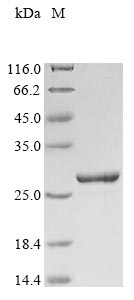CUSABIO transfected the expression vector which inserted the recombinant DNA into the E.coli, cultured the cells, and then induced the transcription and translation of the cloned vector. The N-terminal 6xHis tag sequence was appended to the gene coding for the E.coli of the human FGF18 protein to form the recombinant DNA. The recombinant human FGF18 was expressed as N-terminal 6xHis-tagged fusion. The purity of the protein is greater than 90% assayed by SDS-PAGE. It has an apparent molecular weight of approximately 28 kDa.
Fibroblast growth factor-18 (Fgf18) was the extracellular and secreted factor that decreased glycosaminoglycan release and depletion from the cartilage, and enhanced proliferation of articular chondrocytes. In fact, endogenous Fgf18 is known to play an important role in skeletal growth and development because mice lacking Fgf18 exhibit several malformations such as delayed closure of the calvarial sutures, enlargement of the growth plate, and impairment of osteogenic differentiation. Fgf18 has been reported to have anabolic effects on chondrocytes in other cartilaginous tissues like auricular cartilage, bronchial cartilage, and costal cartilage in animal models. These effects seem to be because of the direct action on mature chondrocytes rather than on the progenitor cells. Fgf18 is generally known to activate the IIIc splice variants of FgfR2 and FgfR3, and both of these receptors are known to be expressed in chondrocytes of human and murine articular cartilage.






